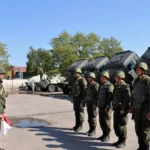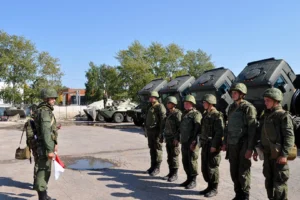For a newcomer to the wonderful world of Middle-earth, the universe created by the British author and academic J.R.R. Tolkien can seem as large and unwieldy as the Marvel Cinematic Universe (currently in Phase Four with more still to come). And, there is a new addition as Amazon’s Lord of the Rings: The Rings of Power (rolls off the tongue, doesn’t it?) hits screens.
The series comes eight years after the concluding film of The Hobbit and 19 years after the last Lord of the Rings film. So if you want to watch the series and keep up with inevitable social media debates, here is a guide to this sprawling world to initiate newcomers to Tolkien’s Middle-earth.
A quick catch-up
The Hobbit (1937) and The Lord of the Rings trilogy (published between July 1954 and October 1955) were Tolkien’s most successful and famous novels.
The Hobbit follows the adventures of the eponymous creature (short of stature, hairy feet), Bilbo Baggins, on a quest with a party of dwarves to reclaim lost treasure. Along the way, he finds a ring that gives him the power of invisibility.
The Lord of the Rings picks up the story many years later as Bilbo’s ring is revealed to be the One Ring, forged by the evil dark lord Sauron as a source of power. Bilbo’s nephew Frodo embarks on a dangerous journey to destroy the ring and save Middle-earth. He is aided by his gardener Sam Gamgee as well as representatives of the other chief races of Middle-earth: two further hobbits, the dwarf Gimli, elf Legolas and two human men, Boromir and Aragorn.
Tolkien served during the first world war and his experiences on the battle-field shape the numerous conflicts depicted in the stories as well as the various forms of heroism that are displayed. In Tolkien’s world, moral courage is just as important, if not more so, than physical prowess for the enduring heroes of Middle-earth.
The close bonds between serving soldiers also inform the interpersonal relationships that are central to The Lord of the Rings – it is evident in the devotion between the hobbits Frodo and Sam and the enemies-to-friends narrative of Gimli and Legolas.
What is Middle-earth?
Middle-earth is the fictional setting for Tolkien’s invented mythology, which made its debut in The Hobbit. However, the term Middle-earth was not used in that book – that came later with The Lord of the Rings.
Tolkien was a professor of English literature and an expert in language, especially in written and oral histories. His mythology for Middle-earth is filled with poems, songs and oral history traditions that help to build the world of different cultures and races (hobbits, elves, dwarves, men) that inhabit his universe. Norse mythology, Anglo-Saxon epic poems, fairy tales and the Finnish mythic poem the Kalevala are all influences on the stories, characters and languages found in Tolkien’s work.
Although The Lord of the Rings and The Hobbit are the best known stories, they’re not the complete history of Middle-earth. The Silmarillion (1977), which was published after Tolkien’s death and edited by his son Christopher and the fantasy writer Guy Gavriel Kay, outlines the thousands of years of history of Middle-earth.
The book charts the creation of Arda, where the continent of Middle-earth is located, and covers the First and Second Ages of the world (The Hobbit and The Lord of the Rings take place in the Third Age). Arda starts as a flat disc and evolves into something more recognisably planet-like over the course of cataclysmic events during repeated battles between forces of good and evil. Further events and characters that shape Arda and Middle-earth feature in Unfinished Tales (1980).
However, as Amazon has only acquired the rights for The Hobbit and The Lord of the Rings, none of the stories from either Unfinished Tales or The Silmarillion will feature in the new series. The extensive appendices to The Lord of the Rings are the source of the material for the new show.
Familiar names
Set in the Second Age of Middle-earth, The Rings of Power takes place thousands of years before either The Hobbit or The Lord of the Rings so there will be few recognisable characters. Sauron, who appeared in The Lord of the Rings as a flaming red eye, is still the big bad.
The creator of the corrupting rings of power and of the infamous One Ring that controls the others, Sauron may not be front-and-centre as an antagonist but his actions and desire for control of Middle-earth will drive much of the action.
The other two familiar names are the elves Galadriel and Elrond, here much younger than they appeared in the films. Galadriel is established as a warrior – which is true to her history as Tolkien wrote it – and there is a lot of scope in the series to see how she develops into the wise ruler of the elven realm Lothlorien.
Elrond Half-elven, the ruler of the enclave of Rivendell, is shown as more optimistic than in The Lord of the Rings and with closer links to the human kingdom of Númenor, whose rulers are descended from his twin brother, Elros.
As the brothers were half-elven, they could choose which of their kindred they would identify as. Elros lived as a mortal and eventually aged and died. Elrond chose to live as an immortal elf and the emotional toll of those decisions will be explored in his story arc.
Fans might be concerned that Tolkien might have disliked some of the liberties taken with his works. While his estate is known to be protective (and litigious) over the original works, Tolkien stated that he wanted other hands to add to his universe. In light of that, he would probably have been delighted to see his creation still so beloved and still expanding.
Source : The Conversation












